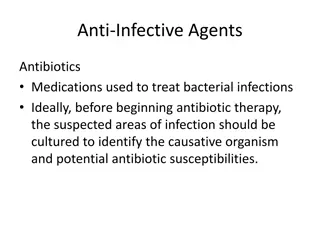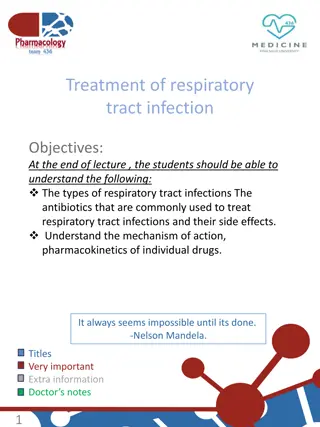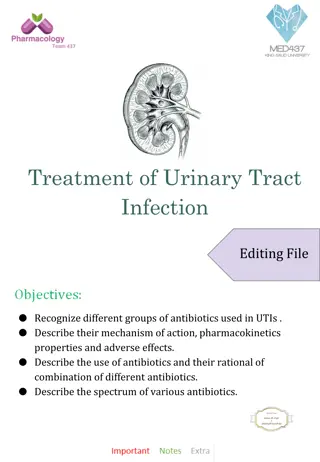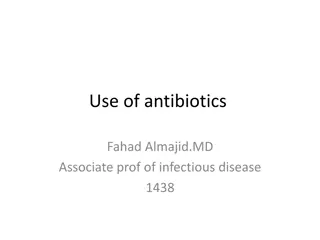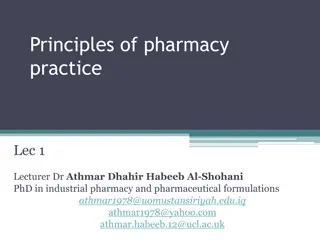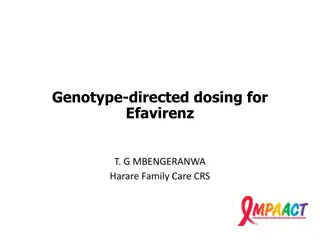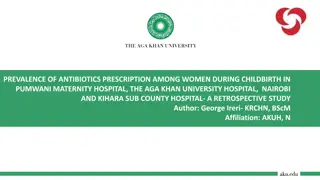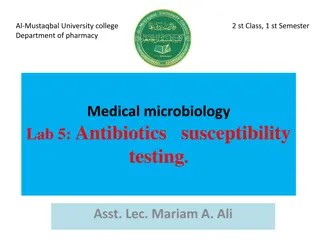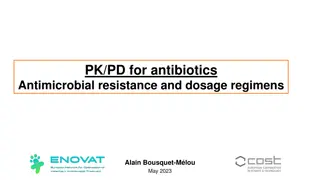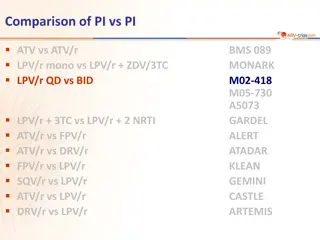Aminoglycoside Antibiotics and Dosing Strategies
Aminoglycoside antibiotics are potent but require precise dosing due to variability among patients. Suggested dosing adjustments based on serum concentrations can ensure therapeutic levels without toxicity. Various methods, like linear pharmacokinetics, individualized dosing, and computerized programs, help optimize aminoglycoside dosages for better treatment outcomes.
Download Presentation

Please find below an Image/Link to download the presentation.
The content on the website is provided AS IS for your information and personal use only. It may not be sold, licensed, or shared on other websites without obtaining consent from the author.If you encounter any issues during the download, it is possible that the publisher has removed the file from their server.
You are allowed to download the files provided on this website for personal or commercial use, subject to the condition that they are used lawfully. All files are the property of their respective owners.
The content on the website is provided AS IS for your information and personal use only. It may not be sold, licensed, or shared on other websites without obtaining consent from the author.
E N D
Presentation Transcript
The Aminoglycoside The Aminoglycoside Antibiotics Antibiotics II II Dr. Haider Raheem Mohammad
Use of Aminoglycoside Serum Concentrations toAlter Dosages Because of pharmacokinetic variability among patients, it is likely that doses computed using patient population characteristics will not always produce aminoglycoside serum concentrations that are expected. Because of this, aminoglycoside serum concentrations are measured in most patients to ensure that therapeutic, nontoxic levels are present. Not all patients may require serum concentration monitoring. For example, if it is expected that only a limited number of doses will be administered as is the case for surgical prophylaxis or an appropriate dose for the renal function and concurrent disease states of the patient is prescribed, aminoglycoside serum concentration monitoring may not be necessary. Choosing aminoglycoside serum concentrations that will not only avoid toxicities but will also achieve target Cmax/MIC values for the infection.
Use of Aminoglycoside Serum Concentrations toAlter Dosages 1. In most cases, a simple dosage ratio can be used to change aminoglycoside doses as these pharmacokinetics. linear antibiotics follow 2. Sometimes, it is not possible to simply change the dose, and the dosage interval must also be changed to achieve desired serum concentrations. In this case, it may be possible to use pharmacokinetic concepts to alter the aminoglycoside dose that the patient needs. 3. In some situations, it may be necessary to compute the aminoglycoside pharmacokinetic parameters for the patient using the Sawchuk-Zaske method and utilize these to calculate the best drug dose.
Use of Aminoglycoside Serum Concentrations toAlter Dosages area under the 4. Some concentration-time curve determinations to individualize aminoglycoside doses. clinicians advocate using individualized 5. Finally, computerized methods that incorporate expected population pharmacokinetic characteristics (Bayesian pharmacokinetic computer programs) can be used in difficult cases where renal function is changing, serum concentrations are obtained at suboptimal times, or the patient was not at steady state when serum concentrations were measured.
Linear Pharmacokinetics Method Because pharmacokinetics, steady-state serum concentrations change in proportion to dose according to the following equation: Dnew/Css,new= Dold/Css,oldor Dnew= (Css,new/Css,old) Dold Where, D is the dose, Css is the steady-state peak or trough concentration, old indicates the dose that produced the steady-state concentration that the patient is currently receiving, and new denotes the dose necessary to produce the desired steady-state concentration. aminoglycoside antibiotics follow linear, dose-proportional The advantages of this method are that it is quick and simple. The disadvantages are that steady-state concentrations are required and that it may not be possible to attain desired serum concentrations by only changing the dose.
Linear Pharmacokinetics Method Example 1 JM is a 50-year-old, 70-kg (5 ft 10 in) male with gram-negative pneumonia. His current serum creatinine is 0.9 mg/dL, and it has been stable over the last 5 days since admission. Agentamicin dose of 170 mg every 8 hours was prescribed and expected to achieve steady-state peak and trough concentrations equal to 9 g/mL and 1 g/mL, respectively. After the third dose, steady-state peak and trough concentrations were measured and were 12 g/mL and 1.4 g/mL, respectively. Calculate a new gentamicin dose that would provide a steady-state peak of 9 g/mL. 1. Estimate creatinine clearance. This patient has a stable serum creatinine and is not obese. The Cockcroft- Gault equation can be used to estimate creatinine clearance: CrClest= [(140 age)BW] / (72 SCr) = [(140 50 y)70 kg] / (72 0.9 mg/dL) CrClest= 97 mL/min
Linear Pharmacokinetics Method Example 1 2. Estimate elimination rate constant (ke) and half-life (t1/2). The elimination rate constant versus creatinine clearance relationship is used to estimate the gentamicin elimination rate for this patient: ke= 0.00293(CrCl) + 0.014 = 0.00293(97 mL/min) + 0.014 = 0.298 h 1 t1/2= 0.693 / ke= 0.693 / 0.298 h 1= 2.3 h Because the patient has been receiving gentamicin for more than 3 5 estimated half-lives, it is likely that the measured serum concentrations are steady-state values.
Linear Pharmacokinetics Method Example 1 3. Compute new dose to achieve desired serum concentration. Using linear pharmacokinetics, the new dose to attain the desired concentration should be proportional to the old dose that produced the measured concentration: Dnew= (Css,new/ Css,old)Dold= (9 g/mL / 12 g/mL) 170 mg = 128 mg, round to 130 mg The new suggested dose would be 130 mg every 8 hours to be started at next scheduled dosing time.
Linear Pharmacokinetics Method Example 1 4. Check steady-state trough concentration for new dosage regimen. Using linear pharmacokinetics, the new steady-state concentration can be estimated and should be proportional to the old dose that produced the measured concentration: Css,new= (Dnew/ Dold)Css,old= (130 mg / 170 mg) 1.4 g/mL = 1.1 g/mL This steady-state trough concentration should be safe and effective for the infection that is being treated.
Linear Pharmacokinetics Method Example 2 ZW is a 35-year-old, 150-kg (5 ft 5 in) female with an intraabdominal infection. Her current serum creatinine is 1.1 mg/dL and is stable. A tobramycin dose of 165 mg every 8 hours was prescribed and expected to achieve steady-state peak and trough concentrations equal to 6 g/mL and 0.5 g/mL, respectively. After the fifth dose, steady-state peak and trough concentrations were measured and were 4 g/mL and <0.5 g/mL (e.g., below assay limits), respectively. Calculate a new tobramycin dose that would provide a steady-state peak of 6 g/mL.
Linear Pharmacokinetics Method Example 2 1- Estimate creatinine clearance. This patient has a stable serum creatinine and is obese [IBWfemales(in kg) = 45 + 2.3(Ht 60 in) = 45 + 2.3(65 60) = 57 kg]. TheSalazar and Corcoran equation can be used to estimate creatinine clearance: CrClest(females)=(146 age)[ 0.287 Wt + (9.74 Ht2)] CrClest(females)=(146 35 y)[ 0.287 150 kg + (9.74 (1.65 m)2)] 60 Scr 60 1.1 mg/dL CrClest(females)= 117 mL/min Note: Height is converted from inches to meters: Ht = (65 in 2.54 cm/in) / (100 cm/m) = 1.65 m.
Linear Pharmacokinetics Method Example 2 2. Estimate elimination rate constant (ke) and half-life (t1/2). The elimination rate constant versus creatinine clearance relationship is used to estimate the gentamicin elimination rate for this patient: ke= 0.00293(CrCl) + 0.014 = 0.00293(117 mL/min) + 0.014 = 0.357 h 1 t1/2= 0.693 / ke= 0.693 / 0.357 h 1= 1.9 h Because the patient has been receiving gentamicin for more than 3 5 estimated half-lives, it is likely that the measured serum concentrations are steady-state values.
Linear Pharmacokinetics Method Example 2 3. Compute new dose to achieve desired serum concentration. Using linear pharmacokinetics, the new dose to attain the desired concentration should be proportional to the old dose that produced the measured concentration: Dnew= (Css,new/ Css,old)Dold= (6 g/mL / 4 g/mL) 165 mg = 247 mg, round to 250 mg The new suggested dose would be 250 mg every 8 hours to be started at next scheduled dosing time.
Linear Pharmacokinetics Method Example 2 4. Check steady-state trough concentration for new dosage regimen. Using linear pharmacokinetics, the new steady-state concentration can be estimated and should be proportional to the old dose that produced the measured concentration. However, in this situation the trough concentration is below assay limits and was reported as <0.5 g/mL. Because of this, the maximum value that the steady-state trough could possibly be is 0.5 g/mL, and this value can be used to compute a rough approximation of the expected concentration: Css,new= (Dnew/ Dold)Css,old= (250 mg / 165 mg) 0.5 g/mL = 0.8 g/mL Thus, the steady-state trough concentration should be no greater than 0.8 g/mL. This steady-state trough concentration should be safe and effective for the infection that is being treated.
Linear Pharmacokinetics Method Example 3 QZ is a 50-year-old, 70-kg (5 ft 10 in) male with gram-negative pneumonia. His current serum creatinine is 0.9 mg/dL, and it has been stable over the last 3 days since admission. A gentamicin dose of 550 mg every 24 hours was prescribed and expected to achieve steady-state peak and trough concentrations equal to 30 g/mL and <1 g/mL, respectively. After the third dose, steady-state peak and trough concentrations were measured and were 37 g/mL and 1 g/mL, respectively. Calculate a new gentamicin dose that would provide a steady-state peak of 30 g/mL and a steady-state trough <1 g/mL. 1. Estimate creatinine clearance. This patient has a stable serum creatinine and is not obese. The Cockcroft- Gault equation can be used to estimate creatinine clearance: CrClest= [(140 age)BW] / (72 SCr) = [(140 50 y)70 kg] / (72 0.9 mg/dL) = 97 mL/min
Linear Pharmacokinetics Method Example 3 2. Estimate elimination rate constant (ke) and half-life (t1/2). The elimination rate constant versus creatinine clearance relationship is used to estimate the gentamicin elimination rate for this patient: ke= 0.00293(CrCl) + 0.014 = 0.00293(97 mL/min) + 0.014 = 0.298 h 1 t1/2= 0.693 / ke= 0.693 / 0.298 h 1= 2.3 h Because the patient has been receiving gentamicin for more than 3 5 estimated half-lives, it is likely that the measured serum concentrations are steady-state values.
Linear Pharmacokinetics Method Example 3 3. Compute new dose to achieve desired serum concentration. Using linear pharmacokinetics, the new dose to attain the desired concentration should be proportional to the old dose that produced the measured concentration: Dnew= (Css,new/ Css,old)Dold= (30 g/mL / 37 g/mL) 550 mg = 446 mg, round to 450 mg The new suggested dose would be 450 mg every 24 hours to be started at next scheduled dosing time.
Linear Pharmacokinetics Method Example 3 4. Check steady-state trough concentration for new dosage regimen. Using linear pharmacokinetics, the new steady-state concentration can be estimated and should be proportional to the old dose that produced the measured concentration: Css,new= (Dnew/ Dold)Css,old= (450 mg / 550 mg) 1 g/mL = 0.8 g/mL This steady-state trough concentration should be safe and effective for the infection that is being treated.
Pharmacokinetic Concepts Method As implied by the name, this technique derives alternate doses by estimating actual pharmacokinetic parameters or surrogates for pharmacokinetic parameters. It is a very useful way to calculate drug doses when the Linear Pharmacokinetic method is not sufficient because a dosage change that will produce a proportional change concentrations is not appropriate. in steady-state peak and trough The only requirement is a steady-state peak and trough aminoglycoside serum concentration pair obtained before and after a dose. This method can be used to adjust doses for either conventional dosing or extended-interval dosing.
Pharmacokinetic Concepts Method The following steps are used to compute new aminoglycoside doses: 1. Draw a rough sketch of the serum log concentration/time curve by hand, keeping track of the relative time between the serum concentrations. 2. Because the patient is at steady state, the trough concentration can be extrapolated to the next trough value time. 3. Draw the between the steady-state concentration and the extrapolated trough concentration. Use this line to estimate half-life. elimination curve peak
Pharmacokinetic Concepts Method For example, a patient receives a gentamicin dose of 80 mg given every 8 hours that produces a steady-state peak equal to 7 g/mL and a steady- state trough equal to 3.2 g/mL, and the dose is infused over hour and the peak concentration is drawn hour later. The steady-state peak and the extrapolated trough concentration is 7 hours (the 8 hour dosage interval minus the 1-hour combined infusion and waiting time). time between the measured
Pharmacokinetic Concepts Method The definition of half-life is the time needed for serum concentrations to decrease by . Because the serum concentration approximately concentration to concentration, the half-life for approximately 7 hours. declined from the aminoglycoside this patient by the peak trough is
Pharmacokinetic Concepts Method 4. concentration between the steady- state peak and trough concentrations. The difference in concentration will change proportionally with the dose size. In the current example the patient is receiving a gentamicin dose equal to 80 mg every 8 hours, which produced steady-state peak concentrations of 7 g/mL and 3.2 g/mL, respectively. The difference between the peak and trough values is 3.8 g/mL. The change in serum concentration is proportional to the dose. Determine the difference in and trough
Pharmacokinetic Concepts Method 5. Choose new steady-state peak and trough concentrations. For the purposes of this example, the desired steady-state peak and trough concentrations will be approximately 7 g/mL and 1 g/mL, respectively.
Pharmacokinetic Concepts Method 6. Determine the new dosage interval for the desired concentrations. In this example, the patient currently has the desired peak concentration of 7 g/mL. In 1 half-life, the serum concentration will decline to 3.5 g/mL, in an additional half-life the gentamicin concentration decrease to 1.8 g/mL, and in 1 more half-life the concentration will decline to 0.9 g/mL. will
Pharmacokinetic Concepts Method Because the approximate half-life is 7 hours and 3 half-lives are required for serum concentrations from the desired peak concentration to the desired trough concentration, the dosage interval should be 21 hours (7 hours 3 half-lives). This value would be rounded off to the clinically acceptable value of 24 hours, and the concentration would be expected to be slightly lower than 0.9 g/mL. to decrease actual trough
Pharmacokinetic Concepts Method 7. Determine the new dose for the desired concentrations. The desired peak concentration is 7 g/mL, and the expected trough concentration is 0.9 g/mL. The change in concentration these values is 6.1 g/mL. It is known from measured serum concentrations that administration of 80 mg changes serum concentrations by 3.8 g/mL and that the change concentration between the peak and trough values is proportional to the size of the dose. between in serum
Pharmacokinetic Concepts Method Therefore, a simple ratio will be used to compute the required dose: Dnew= ( Cnew/ Cold)Dold, where Dnewand Dold are the new and old doses, respectively; Cnewis the change in concentration between the peak and trough for the new dose; and Coldis the change in concentration between the peak and trough for the old dose. For this example: Dnew= (6.1 g/mL / 3.8 g/mL) 80 mg = 128 mg, which would be rounded Gentamicin 130 mg every 24 hours would be started 24 hours after the last dose of the previous dosage regimen. to 130 mg.
Pharmacokinetic Concepts Method Example 1 JM is a 50-year-old, 70-kg (5 ft 10 in) male with gram-negative pneumonia. His current serum creatinine is 3.5 mg/dL, and it has been stable over the last 5 days since admission. A gentamicin dose of 115 mg every 24 hours was prescribed and expected to achieve steady-state peak and trough concentrations equal to 8-10 g/mL and <2 g/mL, respectively. After the third dose, steady-state peak and trough conc. were measured and were 12 g/mL and 3.5 g/mL, respectively. Calculate a new gentamicin dose that would provide a steady-state peak of 9 g/mL and a trough of <2 g/mL. 1. Estimate creatinine clearance. This patient has a stable serum creatinine and is not obese. The Cockcroft- Gault equation can be used to estimate creatinine clearance: CrClest= [(140 age)BW] / (72 SCr) = [(140 50 y)70 kg] / (72 3.5 mg/dL) CrClest= 25 mL/min
Pharmacokinetic Concepts Method Example 1 2. Estimate elimination rate constant (ke) and half-life (t1/2). The elimination rate constant versus creatinine clearance relationship is used to estimate the gentamicin elimination rate for this patient: ke= 0.00293(CrCl) + 0.014 = 0.00293(25 mL/min) + 0.014 = 0.087 h 1 t1/2= 0.693 / ke= 0.693 / 0.087 h 1= 8 h Because the patient has been receiving gentamicin for more than 3 5 estimated half-lives, it is likely that the measured serum concentrations are steady-state values.
Pharmacokinetic Concepts Method Use method to compute a new dose. 1. Draw a rough sketch of the serum log concentration/time curve by hand, keeping track of the relative time between the serum concentrations. 2. Since the patient is at steady state, the trough concentration can be extrapolated to the next trough value time. 3. Draw the between the steady-state concentration and the extrapolated trough concentration. Use this line to estimate half-life. Pharmacokinetic Concepts elimination curve peak
Pharmacokinetic Concepts Method The patient is receiving a gentamicin dose of 115 mg given every 24 hours that produces a steady-state peak equal to 12 g/mL and a steady-state trough equal to 3.5 g/mL, and the dose is infused over hour and the peak concentration is drawn hour later. The steady-state peak and the extrapolated trough concentration is 23 hours (the 24 hour dosage interval minus the 1- hour combined infusion and waiting time). time between the measured
Pharmacokinetic Concepts Method The definition of half-life is the time needed for serum concentrations to decrease by half. It would take 1 half- life for the peak serum concentration to decline from 12 g/mL to 6 g/mL, and an additional half-life for the serum concentration to decrease from 6 g/mL to 3 g/mL. concentration of 3 g/mL is very close to the extrapolated trough value of 3.5 g/mL. Therefore, 2 half-lives expired during the 23-hour time period between the concentration and extrapolated trough concentration, and the estimated half- life is 12 hours (23 hours / 2 half-lives = ~12 hours). The peak
Pharmacokinetic Concepts Method 4. concentration between the steady- state peak and trough concentrations. The difference in concentration will change proportionally with the dose size. In the current example, the patient is receiving a gentamicin dose equal to 115 mg every 24 hours, which produced steady-state trough concentrations of 12 g/mL and 3.5 g/mL, respectively. The difference between the peak and trough values is 8.5 g/mL. The change in serum concentration is proportional to the dose. Determine the difference in peak and
Pharmacokinetic Concepts Method 5. Choose new steady-state peak and trough concentrations. For the purposes of this example, the desired steady-state peak and trough concentrations will be approximately 9 g/mL and <2 g/mL, respectively.
Pharmacokinetic Concepts Method 6. Determine the new dosage interval for the desired concentrations. Using the desired concentrations, it will take 1 half-life for the peak concentration of 9 g/mL to decrease to 4.5 g/mL, 1 more half-life for the serum concentration to decrease to 2.3 g/mL, and an additional half-life for serum concentrations to decline to 1.2 g/mL.
Pharmacokinetic Concepts Method Therefore, the dosage interval will need to be approximately 3 half-lives or 36 hours (12 hours 3 half-lives = 36 hours). When a dosage interval such as 36 hours is used, care must be taken that the scheduled doses are actually administered as the drug will only be given every other day and sometimes this type of administration schedule is overlooked and doses are missed.
Pharmacokinetic Concepts Method 7. Determine the new dose for the desired concentrations. The desired peak concentration is 9 g/mL, and the expected trough concentration is 1.2 g/mL. The change in concentration these values is 7.8 g/mL. It is known from measured serum concentrations that administration of 115 mg changes serum concentrations by 8.5 g/mL and that the change concentration between the peak and trough values is proportional to the size of the dose. between in serum
Pharmacokinetic Concepts Method In this case: Dnew= ( Cnew/ Cold)Dold = (7.8 g/mL / 8.7 g/mL) 115 mg = 105 mg. Gentamicin 105 mg every 36 hours would be started 36 hours after the last dose of the previous dosage regimen.
Semilog Semilog graph graph paper paper
Sawchuk-Zaske Method The Sawchuk-Zaske method of adjusting aminoglycoside doses was among the first techniques available to change doses using serum concentrations. It allows the computation of an individual s own, unique pharmacokinetic constants and uses those to calculate a dose to achieve desired aminoglycoside concentrations. Ronald Ronald J. J. Sawchuk Sawchuk Darwin E. zaske Darwin E. zaske
Sawchuk-Zaske Method The standard Sawchuk-Zaske method conducts a small pharmacokinetic experiment using 3-4 aminoglycoside serum concentrations obtained during a dosage interval and does not require steady-state conditions. The modified Sawchuk-Zaske methods assume that steady state has been achieved and require only a pair of steady-state concentrations obtained during a dosage interval. This method can be utilized to adjust doses for either conventional or extended-interval dosing. The Sawchuk-Zaske method has also been successfully used to dose vancomycin and theophylline.
Standard Sawchuk-Zaske Method The standard version of the Sawchuk- Zaske method does not require steady-state concentrations. A trough concentration is obtained before a dose, a peak concentration is obtained after the dose is infused (immediately after a 1-hour infusion or hour after a - hour infusion), and one to two additional postdose aminoglycoside concentrations are obtained. aminoglycoside aminoglycoside serum
Standard Sawchuk-Zaske Method Ideally, the one to two postdose concentrations should be obtained at least 1 estimated half-life from each other to minimize the influence of assay error. The postdose serum concentrations are used to aminoglycoside constant and half-life. calculate elimination the rate
Standard Sawchuk-Zaske Method The Sawchuk-Zaske method for individualization of aminoglycoside doses uses a trough (Cmin), peak (Cmax), and one or two additional postdose concentrations (C3, C4) to compute a patient s own, unique pharmacokinetic parameters. The peak and trough conc. are used to calculate the volume distribution, and the concentrations (Cmax, C3, C4) are used to compute half-life. Once volume of distribution and half-life have been measured, they can be used to compute the exact dose needed to achieve desired aminoglycoside conc. of postdose
Standard Sawchuk-Zaske Method The elimination rate constant can be directly calculated using the postdose serum concentrations [ke = (ln C1 ln C2)]/ t, Where, C1 and C2 are postdose serum concentrations and t is the time that expired between the times that C1 and C2 were obtained, and The half-life can be computed using the elimination rate constant (t1/2 = 0.693/ke). The volume of distribution (V) is calculated using the following equation: ?/? (1 e ket ) ?? [???? (Cmin e ket ) where D is the aminoglycoside dose, t is the infusion time, ke is the elimination rate constant, Cmax is the peak concentration, and Cmin is the trough concentration. V =
Steady-State Sawchuk-Zaske Method: Peak/Trough Version The steady-state peak/trough version of the Sawchuk-Zaske method uses a steady-state peak (Cssmax) and trough (Cssmin) concentration individualize aminoglycoside therapy. Because the patient is at steady state, consecutive trough concentrations will be identical, so the trough concentration can be extrapolated to the next predose time. pair to
Steady-State Sawchuk-Zaske Method: Peak/Trough Version The steady-state peak and trough concentrations are used to calculate the volume of distribution and half- life. Once volume of distribution and half- life have been measured, they can be used to compute the exact dose needed to aminoglycoside concentrations. achieve desired
Steady-State Sawchuk-Zaske Method: Two Postdose Concentrations Version Sometimes, concentrations will be below the assay limit or it is not possible to measure a predose concentration. Trough concentrations that are too low to accurately measure occur especially during extended-interval dosing. steady-state trough therapy aminoglycoside with
Steady-State Sawchuk-Zaske Method: Two Postdose Concentrations Version In these cases, it may be preferable to measure two postdose steady-state concentrations and use these to compute values that can be used in the Sawchuk-Zaske method. The concentrations should be drawn at least 1 estimated half-life apart in order to minimize the effect of assay error on the calculations. two postdose steady-state





